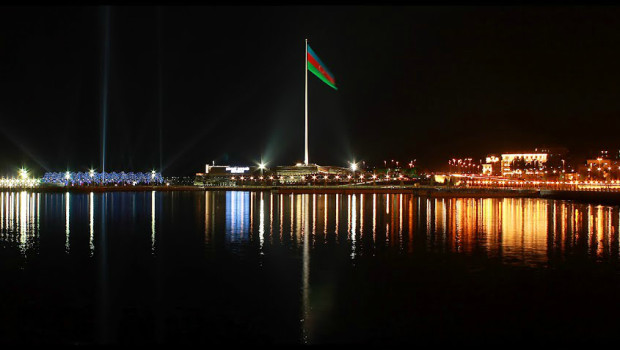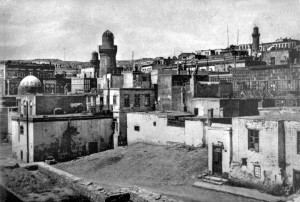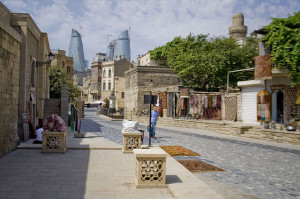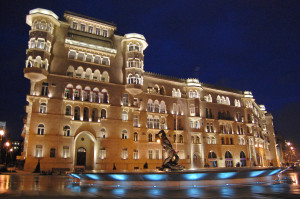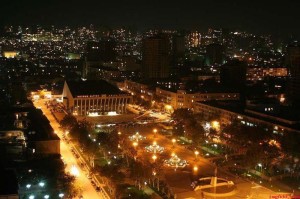Baku (Azerbaijan)
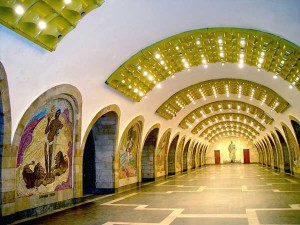 Baku, sometimes known as Baki, is the capital and the largest city of Azerbaijan. Located on the southern shore of the Absheron Peninsula, the city consists of two principal parts: the downtown and the old Inner City (21,5 ha). Population is around 2 millions. There is no one single opinion related to the etymology of the word “Baku” and different assumptions are used in different sources. Here are some of the available versions. The name Baku is widely believed to be derived from the old Persian names ‘Bad-kube’, meaning “Wind-pounded city”, in which “Bad” means wind and “Kube” is rooted in the verb “Kubidan”, to pound, thus referring to a place where wind is strong and pounding. Indeed, the city is renown for its fierce winter snow storms and harsh winds. It is also believed that Baku refers to Baghkuh, meaning “Mount of God”. Baga (now Bagh) and Kaufa (now Kuh) are the Old Persian words for God and Mountain respectively; the name Baghkuh may be compared with Baghdad (God-given) in which ‘da’ is the Old Persian word for ‘give’. Arabic sources refer to the city as Baku, Bakukh, Bakuya, and Bakuye, all of which seem to come from a Persian name.
Baku, sometimes known as Baki, is the capital and the largest city of Azerbaijan. Located on the southern shore of the Absheron Peninsula, the city consists of two principal parts: the downtown and the old Inner City (21,5 ha). Population is around 2 millions. There is no one single opinion related to the etymology of the word “Baku” and different assumptions are used in different sources. Here are some of the available versions. The name Baku is widely believed to be derived from the old Persian names ‘Bad-kube’, meaning “Wind-pounded city”, in which “Bad” means wind and “Kube” is rooted in the verb “Kubidan”, to pound, thus referring to a place where wind is strong and pounding. Indeed, the city is renown for its fierce winter snow storms and harsh winds. It is also believed that Baku refers to Baghkuh, meaning “Mount of God”. Baga (now Bagh) and Kaufa (now Kuh) are the Old Persian words for God and Mountain respectively; the name Baghkuh may be compared with Baghdad (God-given) in which ‘da’ is the Old Persian word for ‘give’. Arabic sources refer to the city as Baku, Bakukh, Bakuya, and Bakuye, all of which seem to come from a Persian name.
Other theories suggest that the name dates back to Zoroastrianism and comes from the word Baga meaning “the god” in Avestan and Sanskrit.
The first written evidence for Baku is related to the 6th century AD. The city became important after an earthquake destroyed Shamakhy and in the 12th century, ruling Shirvanshah Ahsitan I made Baku the new capital. In 1501, Safavid Shah Ismail I laid a siege on Baku. At this time the city was however enclosed with the lines of strong walls, which were washed by sea on one side and protected by a wide trench on land. In 1540 Baku was again captured by the Safavid troops. In 1604 the Baku fortress was destroyed by Iranian shah Abbas I.
On June 26, 1723, after a lasting siege using cannons, Baku surrendered to the Russians. According to Peter the Great’s decree the soldiers of two regiments (2,382 people) were left in the Baku garrison under the command of Prince Baryatyanski, the commandant of the city.
In 1795, Baku was invaded by Agha Muhammad Khan Qajar to defend against the tsarist Russia beginning a policy of subduing the South Caucasus to itself. In the spring of 1796 by Yekaterina II’s order General Zubov’s troops started a large campaign in Transcaucasia. Baku surrendered after the first demand of Zubov who had sent 6,000 militants to capture the city. On June 13, 1796 the Russian flotilla entered the Baku bay and a garrison of the Russian troops was placed in the city. General Pavel Tsitsianov was appointed the Baku’s commandant. Later, however, Tzar Pavel I ordered him to cease the campaign and withdraw the Russian forces. In March, 1797 the tsarist troops left Baku but a new tsar, Alexander I began to show a special interest in capturing Baku. In 1803, Tsitsianov reached an agreement with the Baku khan to compromise, but the agreement was soon annulled. On February 8, 1806, upon the surrendering of Baku, Huseyngulu khan of Baku stabbed and killed Tsitsianov at the gates of the city.
In 1813 , Russia signed the Treaty of Gulistan with Persia, which provided for the cession of Baku and most of the Caucasus from Iran and their annexation by Russia.
OIL BOOM
The basis of Baku’s economy is petroleum. The existence of petroleum has been known since the 8th century. In the 10th century, the Arabian traveler, Marudee, reported that both white and black oil were being extracted naturally from Baku. By the 15th century oil for lamps was obtained from hand dug surface wells. The first oil well was drilled in Bibi-Heybat suburb of Baku in 1846. But the large-scale oil development started in 1872, when the Russian imperial authorities auctioned the parcels of oil-rich land around Baku to private investors. Within a short period of time Swiss, British, French, Belgian, German, Swedish and American investors appeared in Baku, among them were the firms of the Nobel brothers and Rothschilds, and industrial oil belt, better known as Black City, was established near Baku. By the beginning of the 20th century almost half of the oil reserves in the world had been extracted in Baku.
By 1900 the city had more than 3,000 oil wells of which 2,000 of them were producing oil at industrial levels. Baku ranked as one of the largest centres for the production of oil industry equipment before WWII. The World War II Battle of Stalingrad was fought to determine who would have control of the Baku oil fields. Fifty years before the battle, Baku produced half of the world’s oil supply: Azerbaijan and the United States are the only two countries ever to have been the world’s majority oil producer.
In 1917, after the October revolution, in the turmoil of the ongoing World War I and breakup of Russian Empire, Baku came under the control of Baku Commune led by a veteran Bolshevik, Stepan Shaumyan. Seeking to capitalize on the existing inter-ethnic conflicts, by spring 1918, Bolsheviks inspired and condoned a civil warfare in and around Baku. During the infamous March Days, using the support of the Dashnak Armenian militia in the city, and under the pretext of suppressing Musavat party, Bolsheviks attacked and massacred thousands of Azeris and other Muslims in Baku.
On May 28, 1918 the Azerbaijani fraction of the Transcaucasian Seim proclaimed the independent Azerbaijan Democratic Republic (ADR) in Ganja. Shortly after, Azerbaijani forces, with support of the Ottoman Army of Islam led by Nuru Pasha, started their advance onto Baku, eventually capturing the city from the loose coalition of Bolsheviks, Essers, Dashnaks, Mensheviks and the British forces under the command of General Dunsterville on September 15, 1918. Baku became the capital of ADR, and two years later – when on April 28, 1920, the 11th Red Army invaded Baku and reinstalled the Bolshevik power – the capital of Azerbaijan SSR.
The centre of Baku is the old town, which is also a fortress. In December 2000, the Inner City of Baku with the Palace of the Shirvanshahs and Maiden Tower became the first location in Azerbaijan classified as a World Heritage Site by UNESCO. Most of the walls and towers, strengthened after the Russian conquest in 1806, survived. This section is picturesque, with its maze of narrow alleys and ancient buildings: the cobbled streets past the Palace of the Shirvanshahs, two caravansaries (ancient inns), the Maiden Tower (nice view of the harbor), the baths and the Juma Mosque (it used to house the Carpet and Applied Arts Museum, but now is a mosque again; the carpets got moved to the former Lenin museum). The old town also has dozens of small mosques, often without any particular sign to distinguish them from the next building.
Fonte: exploreazerbaijan.com


